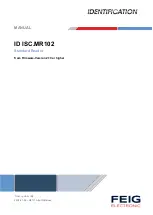
HOIST WITH LOW HEADROOM TROLLEY
This unit should be moved by pushing on the suspended
load or by pulling the empty hook. However, the unit can also
be moved by pulling on the control station since an internal
steel cable extends the length of the control cord and is
anchored to the hoist and to the control station.
HOIST WITH MOTOR DRIVEN TROLLEY
This unit should be moved by operating the controls marked
±
(Forward) and
(Reverse) in control station. Unless altered
by the erector, depressing
±
(Forward) control will move the
hoist toward motor housing end. Anticipate the stopping
point and allow trolley to coast to a smooth stop. Reversing
or “plugging” to stop trolley causes overheating of motor and
swaying of load.
SAFETY PROCEDURES
For safety precautions and a list of
DO’S
and
DO NOT’S
for
safe operation of hoists, refer to
page ii
.
1. When preparing to lift a load, be sure that the attachments to
the hook are firmly seated in hook saddle. Avoid off center
loading of any kind, especially loading on the point of hook.
2. When lifting, raise the load only enough to clear the floor
or support and check to be sure that the attachments to
the hook and load are firmly seated. Continue to lift only
after you are assured the load is free of all obstructions.
3.
DO NOT
load hoist beyond the rated capacity shown on
hoist identification plate or on the hoist motor housing
cover or hoist back frame cover. Overload can cause
immediate failure of some load-carrying part or create a
defect causing subsequent failure at less than rated
capacity. When in doubt, use the next larger capacity of
CM Valustar Hoist.
4.
DO NOT
use this or any other overhead materials han-
dling equipment for lifting persons.
5. Stand clear of all loads and avoid moving a load over the
heads of other personnel. Warn personnel of your inten-
tion to move a load in their area.
6.
DO NOT
leave the load suspended in the air unattended.
7. Permit only qualified personnel to operate unit.
8.
DO NOT
wrap the load chain around the load and hook
onto itself as a choker chain.
Doing this will result in:
a. The loss of the swivel effect of the hook which could
mean a twisted chain and a jammed lift wheel.
b. The chain could be damaged at the hook.
9. On two part-reeved hoists, check for twists in the load
chain. A twist can occur if the lower hook block has been
capsized between the strands of chain. Reverse the cap-
size to remove twist.
10.
DO NOT
allow the load to bear against the hook latch.
The latch is to help maintain the hook in position while the
chain is slack before taking up slack chain.
±
L
L
!!
WARNING
Allowing the load to bear against the hook latch and/or hook
tip can result in loss of load.
TO AVOID INJURY:
Do not allow the load to bear against the hook latch and/or
hook tip. Apply load to hook bowl or saddle only.
11. Take up a slack load chain carefully and start load easily
to avoid shock and jerking of hoist load chain. If there is
any evidence of overloading, immediately lower the load
and remove the excess load.
12. Do not allow the load to swing or twist while hoisting.
INSPECTION
PROCEDURES
To maintain continuous and satisfactory operation, a regular
inspection procedure must be initiated to replace worn or
damaged parts before they become unsafe. Inspection inter-
vals must be determined by the individual application and
are based on the type of service to which the hoist will be
subjected and the degree of exposure to wear, deterioration
or malfunction of the critical components.
The type of service which the hoist is subjected can be clas-
sified as “
NORMAL
,” “
HEAVY
,” “
SEVERE
.”
NORMAL SERVICE:
Involves operation with randomly
distributed loads within the rated load limit, or uniform
loads less than 65 percent of rated load for not more than
25 percent of the time.
HEAVY SERVICE:
Involves operating the hoist within the
rated load limit which exceeds normal service.
SEVERE SERVICE:
Is normal or heavy service with
abnormal operating conditions.
Two classes of inspection,
FREQUENT
and
PERIODIC
, must
be performed.
FREQUENT INSPECTIONS:
These inspections are visual
examinations by the operator or other designated person-
nel. Records of such inspections are not required. The
frequent inspections are to be performed monthly for nor-
mal service, weekly to monthly for heavy service, and
daily to weekly for severe service, and they should
include those items listed in Table 3.
PERIODIC INSPECTIONS:
These inspections are visual
inspections of external conditions by an appointed per-
son. Records of periodic inspections are to be kept for
continuing evaluation of the condition of the hoist.
Periodic inspections are to be performed yearly for nor-
mal service, semi-annually for heavy service and quarter-
ly for severe service, and they are to include those items
listed in Table 4.
CAUTION: Any deficiencies are to be corrected
before the hoist is returned to service. Also, the
external conditions may show the need for disas-
sembly to permit a more detailed inspection, which,
in turn, may require the use of non-destructive type
testing.
Preventive Maintenance
In addition to the above inspection procedure, a preventive
maintenance program should be established to prolong the
useful life of the hoist and maintain its reliability and continued
safe use. The program should include periodic and frequent
inspections with particular attention being paid to the lubrica-
tion of the various components using the recommended lubri-
cants (see page 12).
9
For more information contact: Sievert Crane and Hoist, (708) 771-1600, [email protected], www.sievertcrane.com














































